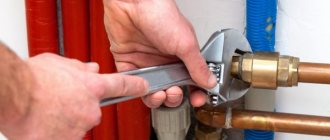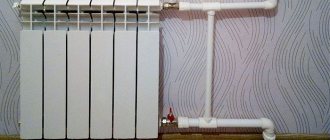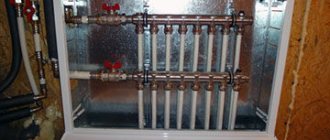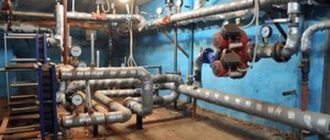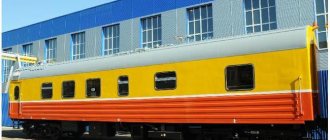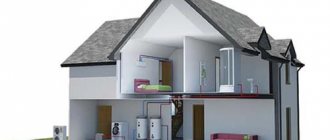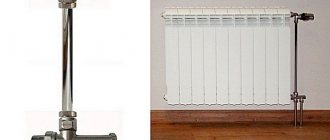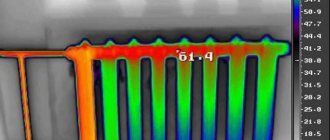Heating systems – requirements and choice
In modern construction, various types of heating systems and many model diagrams of related equipment are used. It is impossible to call one or another solution optimal, since when installing and choosing them, it is necessary to take into account specific conditions and a variety of initial data. However, there are several rules that any heating communications are subject to.
- The heating system in the house must ensure proper temperature regulation. In addition, heat must be efficiently transferred and distributed throughout all heated rooms. The heating system for a private home must meet several criteria, the main ones being:
- High efficiency at minimal cost. According to this indicator, the heating system must produce the required amount of heat for high-quality heating of the premises. At the same time, the costs of its installation and operation must be minimized.
- High degree of automation. In this regard, communications to ensure home heating should be used with minimal human intervention. This maximizes their safety.
Modern heating system with multiple heat sources Source homemarket.ua
- High reliability and wear resistance of all system components. Equipment purchased for installation of communications must be as reliable as possible with a long service life and a warranty from the manufacturer.
Quite often, when installing heating mains, the principle is applied - the simpler, the more reliable.
Boiler
This is the main element of any heating system. It is in the boiler that the process of fuel combustion occurs, here the heat released during this process is transferred to the coolant (water or antifreeze). Currently, 2 types of boilers are produced, differing in their functional features: single- and double-circuit boilers.
Single-circuit boilers perform only one function - heating. A double-circuit boiler is used for heating the room, as well as for heating water. It is believed that a single-circuit boiler is more reliable and convenient to use: if it breaks, there will still be a supply of hot water in the storage tank. If the double-circuit boiler fails, the house will be left without heat and without hot water. However, dual-circuit systems are more popular among owners of country houses.
In a single-circuit system, water is heated in the boiler and moves through pipes to the radiators, then returns to the boiler. Double-circuit boilers have special devices installed that heat water for domestic purposes. Together with double-circuit boilers, storage tanks, so-called boilers, are sold.
Depending on where the boilers are installed, they can be floor-mounted or wall-mounted. The market situation for wall-mounted boilers has recently changed in their favor. There is no doubt that hanging boilers, which usually use atmospheric gas burners, are much better adapted to fluctuations in gas pressure in main pipelines (floor-standing boilers in such situations quickly fail).
The technology of insulating a wooden house will help retain and retain heat.
Types of autonomous heating systems
All heating systems are, first of all, classified according to the type of fuel that is used to heat the coolant. The best option is combination boilers, which allow the use of several types of fuel or energy sources.
A striking example is solid fuel boilers with the ability to connect gas or electricity. There are models on the market that combine several methods of increasing the temperature of the coolant - gas, electricity, solid or liquid fuel.
Such boilers are endowed with all the advantages of standard devices operating on one type of fuel. However, they increase many times over, since several types are combined in one device. Now let's look at the types of heating systems in more detail.
Water heating system with a modern radiator Source www.remontnik.ru
Water heating
This type is the most common. The relative ease of installation and availability of the coolant - water, will retain the relevance of water heating for many years to come. To ensure optimal heating, various installation schemes are used. This can be a two-pipe heating system or a single-pipe heating system.
Radiators made of cast iron or steel act as heat exchangers in such systems. Also, bimetallic equipment or converter-type batteries are popular. The pipeline is made of metal or special plastic. Almost any heating boiler can be integrated into such a system.
Advantages:
- the ability to control the temperature of system components;
- the possibility of installing a pipeline of a smaller cross-section relative to a steam and air heating system;
- high degree of safety during operation;
- fairly low financial costs and minimal requirements for the quantity of consumables;
- no noise during operation;
- uniform heating of all components included in the system.
"Leningrad heating" wiring Source aquasistem.ru
Disadvantages:
- the likelihood of clogging the system with air locks;
- the need for constant monitoring for the performance of the thermal energy source;
- when using metal communications, there is a high probability of corrosion;
- when using old-style radiators, the system warms up slowly;
- difficulties during installation work;
- sensitivity to low ambient temperatures with the risk of system defrosting.
Air heating
In such systems, the room is heated by air flow. Ambient air is taken in by intakes and supplied to the heating element of the system. It can be gas or electric equipment. A water heat exchanger can also be used.
The heated air is forced into the room by means of a fan. When a new portion is taken in, already heated air from the rooms is mixed with fresh air from the street. To do this, it is advisable to install a filter element in the system that will trap dust and other unwanted fractions.
The process is performed cyclically until the room temperature is raised to the required level. The thermostat installed in the system switches off at the desired level and turns on the equipment when it deviates minus one degree.
House air heating diagram Source build-experts.ru
Air heating systems offer high flexibility for the installation of various modules and add-ons. If you install a water cooler or an evaporator from an air conditioner in a channel with a heater, then in the summer you can use communications to create coolness in the room.
If there is a heat pump function in the air conditioner evaporator, in winter this circuit is also used as a heating element. The air supply channel itself can be equipped with a humidifier, sterilizer, ionizer and many other additional devices.
Advantages:
- the ability to install all types of air treatment at “one point”, from filtration to humidification.
- additional operating mode options – air conditioning or heat pump;
- due to controlled ventilation, up to 30% of energy resources are saved in relation to other types of heating;
- excellent comfortable characteristics combining heating, ventilation and air filtration as standard equipment;
- temperature control using a thermostat can be done via the Internet;
- the system is not afraid of low temperatures, has high reliability and a long service life;
- ease of use, since all elements of the system are easily accessible and can be quickly replaced.
Air heating using a fireplace Source stroikairemont.com
Disadvantages:
- most of the work on installing the system should be planned at the building design stage;
- air communications require a certain space in the internal volume of the room.
Types by type of coolant used
Most often, the following networks are used to heat residential or industrial premises:
- water;
- steam;
- air.
The classification of heating systems in this case is made according to the type of coolant used. In addition to water, steam and air, networks can sometimes be used in buildings, for example, radiation, gas, and electric. Stove heating is also called fire-air heating.
Video description
Watch the video to see what air heating is in a house:
Steam heating
This closed heating system remains a fairly popular solution in our time. Various types of fuel are well suited for its operation - solid, gas and electricity. Combined temperature sources are also used, which are given priority during installation work. Proper selection of a steam boiler helps to significantly save on living space heating costs.
The principle of operation of such a system is to bring water to the boiling point. The resulting steam is sent to the heating system. Passing through the communications, it cools and flows back into the steam boiler in the form of condensate. How reliable the system will be during operation directly depends on the model of the steam boiler. It is selected based on the structural features of the heated building and its area.
Advantages:
- quickly achieving the required temperature in the building, regardless of its area;
- low probability of failure at low ambient temperatures;
- cyclical heating process;
- environmental safety of the system.
Boiler for steam heating Source build-experts.ru
See also: Catalog of projects of two-story houses with a boiler room and fireplace
Flaws:
- explosion hazard of the steam boiler and the need for constant monitoring during operation;
- high complexity of installation work;
- high price of components;
- for commissioning it is necessary to obtain permission from the regulatory authorities;
- a fairly high noise level when filling the system with steam;
- negative impact on the operational capabilities of the high coolant temperature system;
- there is no possibility to fully control the temperature conditions indoors.
Gas heating
In areas with main gas communications, heating using liquefied gas is installed. Essentially, this is a type of water heating. It’s just that in this case gas acts as the main source of energy. However, both air and steam systems can be implemented on this basis.
In the absence of main gas lines, you can organize a small gas storage facility, which is filled with liquefied gas for the heating season. Also, in subsidiary farms it is practiced to use gas tanks - special devices that collect gas from silos and cesspools.
Floor-standing gas boiler Source www.ural.org
Advantages:
- long service life of the system equipment;
- high level of fuel economy;
- ecological purity of the energy source.
Flaws:
- high complexity of installation work;
- high cost of system components;
- the need to obtain permission from regulatory authorities;
- the need for constant monitoring by service departments;
- in the absence of a main connection, additional costs for the necessary equipment;
- in the absence of main gas lines, it is difficult to refuel the system.
Electric heating
Not so long ago, electric heating systems were quite popular, but rising electricity prices have significantly reduced the demand for such a solution. In the current situation, from an economic point of view, this choice is justified only by hopelessness and the lack of alternatives.
In such systems, the coolant is convectors, fireplaces, infrared heaters and heated floors. There are many electric boilers sold on the market to organize not only heating systems, but also to provide residential premises with hot water for domestic use.
Wall-mounted electric boiler Source avatars.mds.yandex.net
Advantages:
- fairly affordable prices for system components;
- the use of electric boilers in hot water supply systems simultaneously with space heating;
- mobility of many system components;
- no need for maintenance with serious financial costs;
- ample opportunities for automating the process and maintaining optimal temperature conditions in the building;
- environmental safety of the heat source.
Flaws:
- high power required for system operation - up to 24 kW per hour;
- high cost of electricity;
- system failures and even failure due to serious power outages.
Water heating
is the most widely used .
Advantages
- You can use one or more heat sources. According to physical parameters, water transfers thermal energy well. Heating devices, such as radiators, give off this heat, heating the air in the room.
- Versatility in fuel use. There are many ways to heat water. You can heat the premises with wood or coal, purchase a liquid fuel boiler, or supply natural gas. Finally, it is possible to heat water using boilers that run on electricity.
- Availability of materials and wide selection of products. The most suitable option for heating devices is easily selected (cast iron radiators, modern bimetallic radiators, convectors and other devices). A large selection of pipes from various materials (iron, copper, polypropylene, metal-plastic, etc.) will allow you to create a heating system that suits any budget.
Water heating can be connected either from centralized networks or performed autonomously. According to the design of the water heating system, there are:
a) Single-pipe. Radiators are connected in series.
b) Two-pipe. In this case, the radiators are powered in parallel between the supply and return lines.
c) Collector or, in other words, radial. All heating devices are powered from a common distributor called a manifold.
Flaws
The disadvantages of water heating are also well known. This is a high susceptibility to corrosion and oxidation processes, uneven heating of radiators in some cases, and fairly large losses during heat transportation. In emergency situations, a coolant leak may occur.
Also, such a system requires compliance with the temperature regime. At sub-zero temperatures, it is necessary to completely drain the coolant from the networks to prevent them from freezing.
Video description
Watch the video to see all the pitfalls when installing heating in a private home:
See also: Catalog of companies that specialize in electrical and heating.
Geothermal heating
When choosing energy resources provided by the earth as a heat source, this means obtaining an environmentally friendly and economical home heating system. Along with gas heating, one of the energy sources is geothermal heat from the earth. The soil absorbs about 98% of all energy coming from the sun. There is always heat in the deep layers and this does not depend on the time of year and temperature on the surface.
The geothermal heating system consists of two circuits - external and internal. External communications are responsible for switching between the heat exchanger and the internal circuit of the system. They are deep underground.
Geothermal heating scheme Source respect-stroy.com
The internal circuit is a classic one-pipe system or a two-pipe heating system for a private house with radiators. The coolant in them is either water or another suitable liquid, for example, special oil.
Advantages
- minimal dependence of the system on climatic conditions;
- low costs for operating the system;
- stable flow of thermal energy in the required quantity;
- environmental safety of the heat source.
Flaws:
- high complexity of installation work;
- high cost of system components;
- low payback of the system - about 8 years;
- it is necessary to construct a collector.
Installation methods
Let's touch on methods for installing heat-carrying communications. There is no clear opinion on this issue. Much depends on the specific conditions and preferences of the specialist performing the work.
The most common installation options are a single-pipe or two-pipe heating communications system. We will not dwell on them, but will tell you about two lesser-known methods.
Collector system
The main unit with this installation method in this system is the collector, which is responsible for the distribution of the coolant.
Manifold for a single-pipe heating system Source termoresurs.ru
Video description
This video will show you how to make a manifold for a heated floor with your own hands:
A collector heating system, also known as a radiant heating system, consists of the following elements:
- collector;
- pump;
- heating devices;
- safety devices;
- expansion tank;
- pipeline;
In turn, the collector assembly is mounted in two parts:
- Input - it is connected to the heating unit, receiving the coolant at the required temperature, and distributes it along the circuits of the system.
- Output - return circuits are connected to it, which release the cooled coolant, which is redirected to the boiler for the next heating.
The main difference and advantage of this installation method is the ability to independently connect heating devices to the system. This allows you to simplify repair work and more accurately regulate the temperature in the room. The disadvantage is the high costs of communication and installation.
Leningradka system
Another interesting solution is the Leningrad heating system. The Leningradka heating system in a private house allows you to level out heat loss by the coolant when moving away from the boiler.
This is the main problem of classical type heating systems - achieving the same temperature along the entire length of the line. To solve this problem, it is necessary to increase the number of heating devices as they move away from the heat source.
Radiator installed according to the “Leningradka” scheme Source plusteplo.ru
Differences in Sealing
All heating systems are divided into two types - open and closed heating systems, the difference is that open communications communicate with the atmosphere, while closed ones do not.
Open systems
An open heating system has a leaky expansion tank. A drain pipe is installed in it, which drains excess water into the sewer or outside the building. The shape of the vessel does not matter in this case. The tank is located at the highest point of thermal communications.
Scheme of an open type heating system Source avatars.mds.yandex.net
Since the tank has an easy-to-open lid, the system can be filled with water manually using buckets or a hose. The pressure in the circuits is always equal to atmospheric pressure and for this reason such systems do not require the installation of monitoring devices and are safer during operation.
Closed systems
A closed-type heating system with a pump and expansion tank is more complex to install. The elements included in the composition are completely sealed and the shape of the tank is important; it is selected in such a way as to withstand pressure with a minimum wall thickness.
Such systems require more careful attention because they contain high pressure. To ensure safety during operation, it is necessary to install control devices and an emergency valve on the expansion tank.
Closed heating system with forced circulation Source dpa.cv.ua
Burner
Heat generators operating on gas fuel are divided according to the type of burners used. They are ventilated and atmospheric.
Boilers equipped with fan burners operate without interruption at reduced pressure, but they have one significant drawback: they are very noisy.
Boilers with atmospheric burners, on the contrary, operate silently, but can only operate if the gas pressure is not lower than 150 mm of water, art. If the pressure decreases, the boiler begins to operate at approximately 80% power, resulting in the burner burning out.
This does not happen with fan burners, so it is better to choose them.
